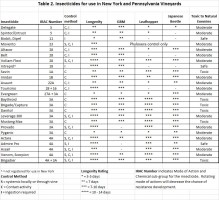Insecticides for use in New York and Pennsylvania Vineyards (Table)
Edith Byrne, Association Program Educator I
Lake Erie Regional Grape Program
August 7, 2013

Coming up with the best timing of the various types of insecticides has always been a good topic of discussion. Andy Muza and Tim Weigle have put together a Table: Insecticides for use in New York and Pennsylvania Vineyards (based on one developed by Rufus Isaacs at Michigan State University).
The hope is that this Table will be of help in determining the different modes of action to assist you, the grower, in selecting the best insecticide and timings as well as to assist you in developing a resistance management program. Time materials that need to be ingested close to 1620 DD as determined by the GBM model on NEWA and for contact materials wait an additional 100 DD and apply them at 1720 for the best efficacy.
To get the latest in model information for both grape berry moth and the grape diseases, powdery mildew, downy mildew, black rot and Phomopsis, get on the NEWA website at http://newa.cornell.edu and access the station, or stations, nearest you.
Insecticides for use in New York and Pennsylvania Vineyards (pdf; 485KB)
Upcoming Events
LERGP Coffee Pot Meeting
July 2, 2025
Irving, NY
Come join us for timely and pertinent vineyard discussion, coffee, donuts and camaraderie.
NO COFFEE POT MEETING
July 9, 2025 : LERGP Coffee Pot Meeting
LERGP Coffee Pot Meeting
July 16, 2025
Portland, NY
Come join us for timely and pertinent vineyard discussion, coffee, donuts and camaraderie.
Announcements
 Lake Erie Regional Grape Program - Cornell Cooperative Extension
Lake Erie Regional Grape Program - Cornell Cooperative ExtensionYour Trusted Source for Research-Based Knowledge


